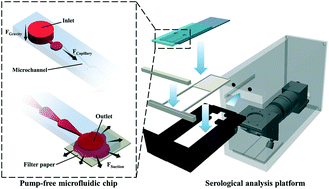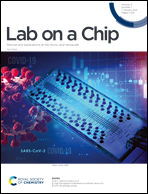A flux-adaptable pump-free microfluidics-based self-contained platform for multiplex cancer biomarker detection†
Abstract
Microfluidics drives technological advancement in point-of-care (POC) bioanalytical diagnostics towards portability, fast response and low cost. In most microfluidic bioanalytical applications, flowing antigen/antibody reacts with immobilized antibody/antigen at a constant flux; it is difficult to reach a compromise to simultaneously realize sufficient time for the antigen–antibody interaction and short time for the entire assay. Here, we present a pump-free microfluidic chip, in which flow is self-initialized by capillary pumping and continued by imbibition of a filter paper. Microfluidic units in teardrop shape ensure that flow passes through the reaction areas at a reduced flux to facilitate the association between antigen and antibody and speeds up after the reaction areas. By spotting different antibodies into the reaction area, four types of biomarkers can be measured simultaneously in one microfluidic chip. Moreover, a small-sized instrument was developed for chemiluminescence detection and signal analysis. The system was validated by testing four biomarkers of colorectal cancer using plasma samples from patients. The assay took about 20 minutes. The limit of detection is 0.89 ng mL−1, 1.72 ng mL−1, 3.62 U mL−1 and 1.05 U mL−1 for the assays of carcinoembryonic antigen, alpha-fetoprotein, carbohydrate antigen 125 and carbohydrate antigen 19-9, respectively. This flux-adaptable and self-contained microfluidic platform is expected to be useful in various POC disease-monitoring applications.



 Please wait while we load your content...
Please wait while we load your content...